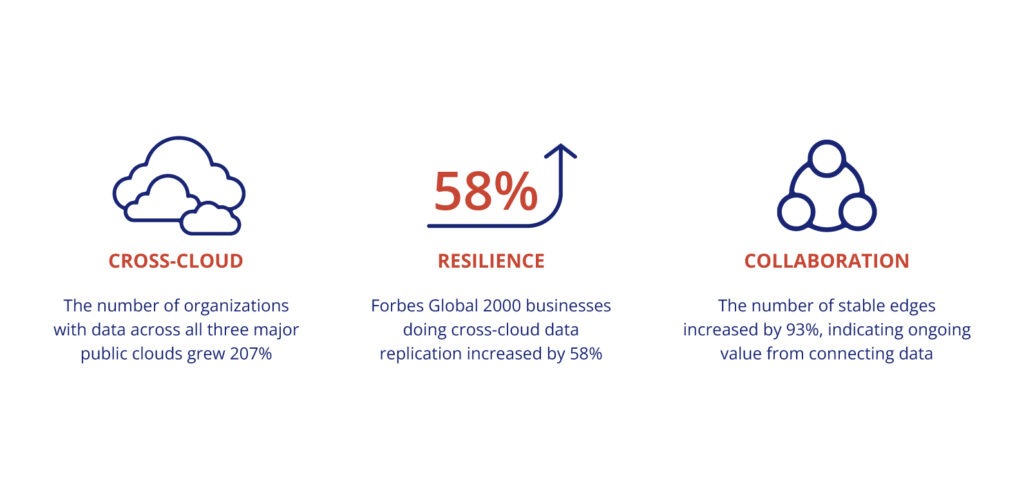Data, the unparalleled force driving transformation, is shaping the world as we know it. It goes beyond mere information, leaving an indelible mark on research, policies, and innovation.
But what is fueling this transformative power? The answer lies in Generative AI, a game-changer made possible by data availability. It has compelled global industries to reassess their fundamental workflows and processes, resulting in a significant shift across software and enterprises.
Data has endless applications in healthcare, entertainment, automotive, and retail. In cybersecurity, it empowers teams to respond swiftly to evolving threats, surpassing human capabilities. Data will drive drastic changes in workflows, software categories, and job roles in the coming years. Are you ready for the future?
Explore the latest data trends to learn how data-driven enterprises prepare themselves for the generative AI era. Gain insights from leading organizations leveraging their data to enhance decision-making and expedite positive outcomes.
Trend 1: Enterprises are connecting Data to AI across industry ecosystems and cloud environments
As outlined in McKinsey’s “The Data-Driven Enterprise of 2025,” the forecast for 2025 envisions data integration into every facet of interaction, decision-making, and operational processes. This projection gains significance with the widespread incorporation of large-scale AI models into various business operations. Consequently, most global companies are preparing for a future deeply rooted in AI technology.
Alignment between real-world actions and predicted trends is evident as more companies spread their data across multiple clouds for improved business continuity, resilience, and collaboration. Furthermore, research indicates that the number of customers operating across Snowflake, AWS, Azure, and Google Cloud increased by 207%, highlighting the demand for global data sharing.
Most businesses prioritize resilience, using cross-cloud replication for smooth transitions between competing clouds. A clear example of this can be seen in the Forbes Global 2000, where customers on the Snowflake Cloud platform saw a 58% increase in cross-cloud replication each year.
The growing trend of collaboration across regions and cloud providers is further evidenced by Snowflake’s 93% increase in tasks executed using shared data between February 2022 and January 2023. This significant growth demonstrates the efficiency gains and seamless data sharing that Snowflake enables, eliminating the need for time-consuming data processing beforehand. This collaborative approach transforms how organizations leverage data across different regions and cloud environments.
The growing adoption of data sharing within the Snowflake Data Cloud is further underscored by the 93% increase in stable edges throughout the year. Stable edges represent the enduring value of data sharing, and this substantial growth indicates that Snowflake users have nearly doubled their utilization of shared data to achieve better outcomes. This trend highlights the transformative impact of Snowflake in facilitating seamless data sharing across organizations.
Organizations persist in refining data connections to elevate processes and gain deeper insights, embracing successful innovations. Notably, in 2023, the number of organizations with data across all three major public clouds surged by 207%.

Trend 2: Enterprises break free from silos; bring work, including AI, directly to the data
Another source of data silos is the diverse formats and specialized systems in which data is generated and consumed. Unifying different data formats and types (structured, unstructured, semi-structured) remains a persistent challenge.
Companies have made incremental progress on these challenges for over a decade. However, only storing all data in one location is less meaningful if it requires extracting and preparing separate datasets for each task.
The next big step, crucial for the emerging era of generative AI, is effectively utilizing the unified data together on a single platform or engine. The Snowflake Data Cloud is a prime illustration of a platform facilitating comprehensive data analysis within the same framework. This platform supports various tasks, including building data processing pipelines, training machine learning models, creating analytic queries, developing dashboards, and powering entire applications.
Furthermore, according to insights gathered, by January 2023, Snowflake had accumulated over 800 companies in the Powered by Snowflake program, assisting them in building, supporting, and scaling applications in the Snowflake Data Cloud. Snowflake users perform billions of jobs daily on the data within the Snowflake Data Cloud, with the number of jobs increasing by 64% over the year, surpassing customer growth.
Therefore, after having delved into the stats mentioned above, it’s evident that making data more accessible for different tasks can spark users’ interest in tapping into their entire data storage where it already exists to unearth fresh insights rather than moving data around unnecessarily.D
Trend 3: Governance is more important than ever in the new AI era
Data governance is pivotal in effective data management, shaping how organizations understand, safeguard, and leverage their data assets. Establishing clear roles, processes, and policies for data interaction fosters reliable business insights and ensures compliance with regulatory standards.
The increasing importance of compliance is reflected in the surge of global data protection regulations. However, adequate data governance extends beyond compliance, acting as a catalyst for extracting the total value from data, especially in the era of generative AI and LLMs.
A consistent and robust data governance model is essential for reliability and security. It ensures authorized access to specific datasets, employing automated controls like classification, tagging, masking, and granular role-based access controls (RBAC).
Industry experts highlight the growing focus on data governance. Reports emphasize “adaptive data governance” as a crucial trend and recommend establishing enterprise-wide data governance programs.
Analyzing usage within the Snowflake Data Cloud, a significant increase in users applying native governance controls, such as dynamic masking policies, for scalable data understanding and protection. The number of active dynamic masking policies for capacity customers grew by over 205% from Feb 2022 to Jan 2023 —six times more than the Snowflake customer base, indicating a global trend towards stringent governance.
Additionally, substantial growth in object tagging, enhancing data context, utilization, and automation was observed. Users leverage tags to track PII, with a nearly 40x increase comparing February 2022 to January 2023.
These trends suggest a shift towards unified platforms like Snowflake, favoring a comprehensive and centralized approach to data governance. Organizations increasingly recognize the importance of managing, protecting, and utilizing data assets, including AI models, within a unified framework.
Trend 4: Enterprises ride automation wave, anticipating fully managed platform integration
Increasingly, customers leverage automation capabilities for enhanced efficiency and reduced operating costs. The significance of this trend grows as running massive AI models demands scale, expertise, and preparation for unpredictable resource needs. Human speed falls short; organizations must elevate their automation approaches.
An illustrative instance is resizing compute resources to optimize them and enhance query performance. In 2023, research indicates that millions of automated warehouse resize events were performed daily by Snowflake to adapt to customer requirements. A 71% increase in such activity was reported between February 2022 to January 2023.
The expanded use of automation poses a new challenge for CIOs, CDOs, and data platform administrators: establishing financial governance. Resource usage tracking by department or purpose becomes crucial for aligning costs with value, given the abundance of resources unlocked by the cloud, enabling rapid value delivery.
Automation, not only driving AI but also being powered by it, is recognized in trends such as cloud resource optimization, edge computing, and DevSecOps. In the Data Cloud, data and IT experts demonstrate readiness to capitalize on this automation, optimizing performance and minimizing costs.
The Keys to AI and Data Excellence
Each of these four trends offers unique opportunities to devise strategies catering to business requirements and the competitive environment. The following are crucial recommendations drawn from specific trends and a comprehensive examination of how leading organizations embrace novel possibilities to leverage their data for enhancing decision-making and expediting positive outcomes.
Eliminate Obstacles to Collaboration
Despite efforts to consolidate data in a unified location, many enterprises face challenges as their processes or tools inadvertently create new silos, hindering collaboration and diminishing efficiency. The goal is to interact with data seamlessly across global teams, diverse business units, and third-party providers.
Modernizing the data environment with a focus on data security and shareability while minimizing wait times is critical. Instant access to live data can foster impactful insights across analyst teams, data scientists, and other collaborators.
Support Teams in Utilizing their Preferred Language
Individuals working in technical teams tend to have preferred programming languages and often lean towards tools specifically designed for that language, such as Python, SQL, Scala, etc. While this can sometimes create translation challenges, allowing teams to use the tools and languages they are most comfortable with is crucial.
It’s important to modernize the environment to allow people to use their preferred tools and languages while implementing shared governance, ensuring proper performance capabilities, and more. Otherwise, organizations risk creating incompatible and inflexible work processes that can cause data to be re-siloed.
Transform Governance into an AI Catalyst
Data governance protects and regulates data access per region-specific policies and regulations. However, limiting data access for security reasons may unintentionally limit the data’s potential value. It is crucial to shift the focus of data governance to enable safe data utilization. To prevent confusion, avoid creating multiple copies of the same dataset. Enable access to a single dataset for authorized users through role-based dynamic masking.
Automate data governance across systems and clouds, consolidating management in one centralized hub. Prioritize governance upfront during data ingestion and usage planning. This proactive approach ensures data protection while maximizing its value. By rethinking data governance, enterprises can safeguard and unlock its full potential.
Automate to Minimize Total Cost of Data System Ownership
As data volumes and complexities increase, manual optimization becomes impractical for organizations. Automation helps scale and prevent costly errors, such as neglecting to deactivate development environments.
Automation not only safeguards but also frees teams to focus on innovation rather than tedious tasks like upgrades and maintenance. Streamlined automation reduces resource waste and boosts productivity, delivering more value to the organization. It empowers teams to unleash their full potential in contributing to organizational success.
Conclusion
Data is the new currency of the digital age, and organizations that effectively leverage it will be the future pioneers. By embracing these data trends, businesses can unlock the transformative power of data, driving innovation, enhancing productivity, and achieving sustainable growth.
To find out how Snowflake can facilitate data analysis within the same framework, help you unlock the true power of your data, and do so much more, connect with our experts today!




